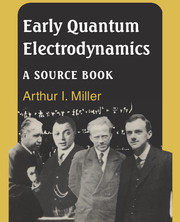Book contents
- Frontmatter
- Contents
- Preface
- Notes to the Preface
- Acknowledgements
- Notes to the Reader
- I Frame-setting essay
- Epilogue
- Notes
- References to the Frame-setting essay
- II Selected papers
- 1 The self-energy of the electron
- 2 Remarks on radiation theory
- 3 Theory of the positron
- 4 Discussion of the infinite distribution of electrons in the theory of the positron
- 5 The self-energy of the electron
- 6 Remarks on the Dirac theory of the positron
- 7 The quantization of the scalar relativistic wave equation
- 8 The electrodynamics of the vacuum based on the quantum theory of the electron
- 9 Theory of the emission of long-wave light quanta
- 10 The universal length appearing in the theory of elementary particles
- 11 The interaction between charged particles and the radiation field
- Index to Frame-setting essay
1 - The self-energy of the electron
Published online by Cambridge University Press: 05 August 2012
- Frontmatter
- Contents
- Preface
- Notes to the Preface
- Acknowledgements
- Notes to the Reader
- I Frame-setting essay
- Epilogue
- Notes
- References to the Frame-setting essay
- II Selected papers
- 1 The self-energy of the electron
- 2 Remarks on radiation theory
- 3 Theory of the positron
- 4 Discussion of the infinite distribution of electrons in the theory of the positron
- 5 The self-energy of the electron
- 6 Remarks on the Dirac theory of the positron
- 7 The quantization of the scalar relativistic wave equation
- 8 The electrodynamics of the vacuum based on the quantum theory of the electron
- 9 Theory of the emission of long-wave light quanta
- 10 The universal length appearing in the theory of elementary particles
- 11 The interaction between charged particles and the radiation field
- Index to Frame-setting essay
Summary
Zeitschrift für Physik, 65: 4–13 (1930). Received 3 August 1930.
The behavior of very fast electrons is investigated, whose energy is large compared with mc2 and Mc2. Since the rest mass of the electron can be neglected for such motions, a characteristic electron radius plays no role in the question of self-energy. The conditions are investigated under which the self-energy of the electron vanishes.
Introduction
In classical theory, the field strengths E and H become arbitrarily large in the neighborhood of the point-charge e, so that the integral over the energy density 1/8π(E2 + H2) diverges. To overcome this difficulty, one therefore assumes a finite radius r0 for the electron in classical electron theory. This radius is related to the mass m of the electron in the order-of-magnitude relation r0 ~ e2/mc2; the integral over the energy density is then of the order mc2. In quantum theory, not only this radius r0 but possibly also another length λ0 = h/mc, which is characteristic of the electron, plays a role in the self-energy. In a superficial consideration in terms of the correspondence principle, one would suspect that the self-energy of the point-like electron must also become infinite in quantum theory.
In fact, Oppenheimer and Waller have indeed shown that a perturbation method which proceeds in powers of e does not yield finite values for the self-energy. At first, it appears as if, in quantum theory also, only the introduction of a finite electron radius can provide a way out of this difficulty.
- Type
- Chapter
- Information
- Early Quantum ElectrodynamicsA Sourcebook, pp. 121 - 128Publisher: Cambridge University PressPrint publication year: 1994
- 1
- Cited by



